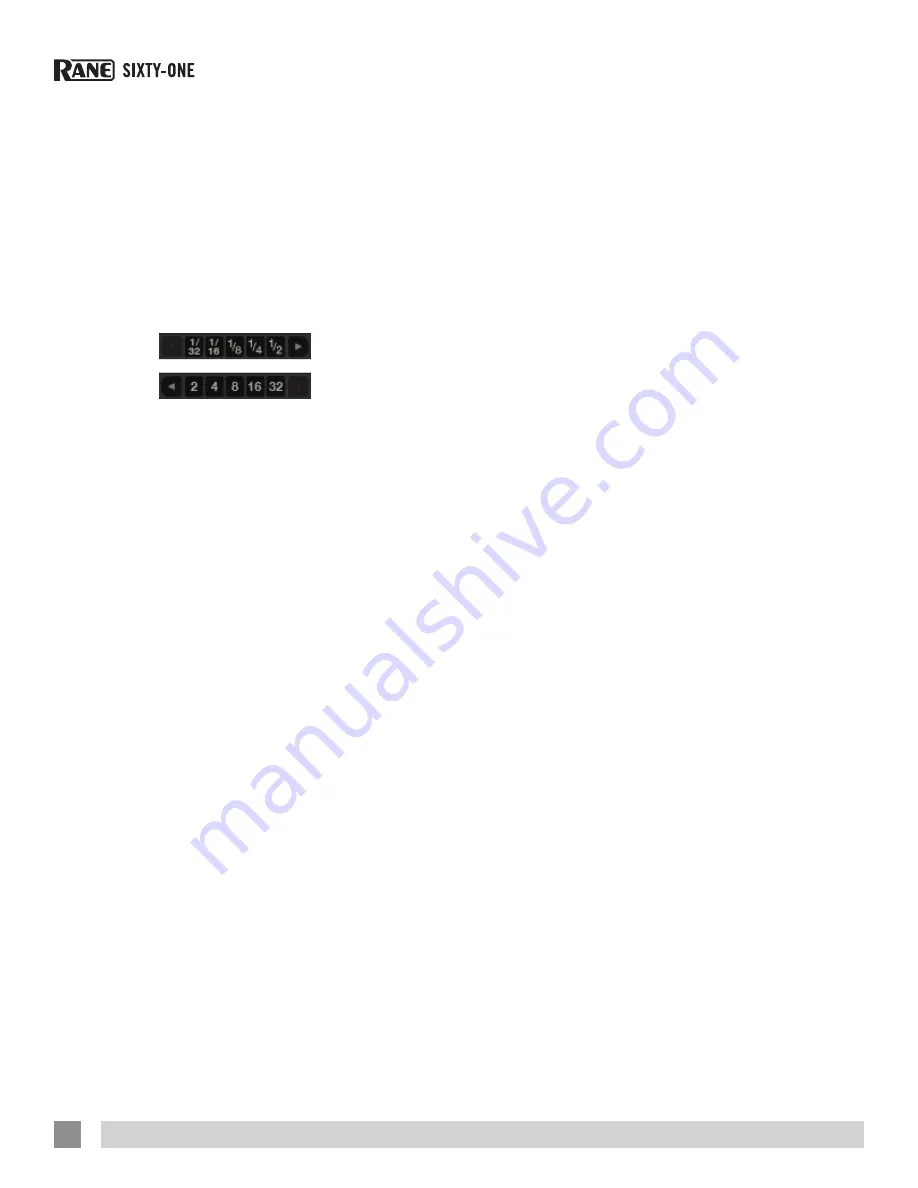
will be green. Press the
x
button to clear
the loop. If you click on the locked loop
symbol, a red border will appear. This
indicates the loop is locked, and you
will not be able to adjust the end points
or delete the loop until you unlock it, by
clicking on the number again.
NOTE: Looping applies to REL and INT
modes.
Auto-Looping
Auto-looping
allows you to
create loops
instantly. If
the track has
a BPM value simply click the number of
beats you wish to loop and Scratch Live
will create the loop for you. The loop is
snapped to the beats in the song detected
by Scratch Live so even if you press the
button slightly out of time Scratch Live will
still create a perfect loop for you.
Five auto-loop buttons are available on
screen at any one time. They range from
1/32 to 32 beats. The user can select
the auto-loop range with the
and
buttons.
Pressing an auto-loop button will create
a loop start point from the nearest beat
to the playhead (within reason), and set
a loop endpoint in the future. Pressing
auto-loop 1 while auto-loop 1 is active will
deactivate the loop. Pressing a different
auto-loop button while looping is active
will extend the endpoint of the current
loop to the appropriate new auto-loop
length.
You can also save an auto-loop to the
next available slot. When using an auto-
loop, a
save button is visible where
the lock loop button normally is.
NOTE: Auto-looping requires the track
BPM to be set. See “Set Auto BPM” on
page 16.
The A-Slot
A special loop slot ‘A’ exists for auto-
looping. The act of using the auto-loop
buttons sets a loop in the ‘A’ slot,
following the rules above. Turning a
loop off using the auto-loop buttons
returns you to the loop slot that you
were previously in at the time you started
auto-looping. Turning the loop off using
the LOOP button leaves you in the ‘A’
slot. The ‘A’ slot is not saved to disk
automatically, pressing ‘save’ saves the
loop to the first empty slot in 1-9.
Auto-looping shortcut keys are alt-1
to 5 for the Left Deck, and alt-6 to 0 for
the Right Deck. They correspond to the
looping buttons as laid out on screen. ie.
if the onscreen buttons display 1 2 4 8 16
beat loops, alt-1 triggers a 1 beat loop,
and alt-5 triggers a 16 beat loop.
Loop Roll
Loop roll performs a standard auto-
loop, but when the loop is turned off,
the playback position is returned to the
position where it would be if it had not
entered the loop (much like censor).
The other difference between loop
roll and standard auto-loop is the ‘‘roll’’
button is momentary. The loop is engaged
when the button is pressed down, and
disengaged when the button is released.
Use short loop lengths to create “stutter”
type effects.
To activate loop roll, hold c alt
while clicking on the desired autoloop
increment, or use the keyboard shortcuts:
c alt + 1 through 5 for the Left
Deck and c alt + 6 through 0 for
the Right Deck. (ie. the same as the auto-
loop controls with the additional ‘alt’ key
as a modifier).
The range of values available for loop
roll are 1/32 through to 32 beats. The
shortcut keys will activate whichever loop
lengths are visible on screen, i.e., if you
have lengths of a 1/4 beat through to 4
beats visible for the Left Deck, c
alt + 1 will activate a 1/4 beat loop roll,
c alt + 2 will activate a 1/8 beat
loop roll and so on.
Use the
and
buttons to toggle
through the range of possible lengths
visible onscreen.
Loop Roll with MIDI
You can assign loop roll to MIDI two ways:
1.
After pressing the
MIDI
assign button
in Scratch Live, press the c alt
keys, click on an auto-loop value, then
click on the button/slider you want it
mapped to on your MIDI controller.
2.
You can assign the singular loop roll
button to MIDI, then assign a MIDI
knob or slider on your controller to the
autoloop select knob (visible in the MIDI
assign panel area when in MIDI assign
mode) to change the values on the fly.
TIP: When you have the “Autoloop
Select” knob assigned to MIDI, you
have all of the loop roll lengths at your
disposal. This allows you to roll up and
down the loop length scale, to create
interesting stutter and build-up effects.
NOTE: Like auto-loop, loop roll requires
a BPM value written to the ID3 tag in
order to work. Build overviews with the
“Set Auto BPM” box checked and the
proper range for your music selected
to ensure an accurate BPM value. See
“Set Auto BPM” on page 16
To use the Loop controls on the Sixty-
One, see “FlexFx” on page 10.
RANE SIXTY-ONE MIXER FOR SERATO SCRATCH LIVE • OPERATOR’S MANUAL 2.4.4
24






























